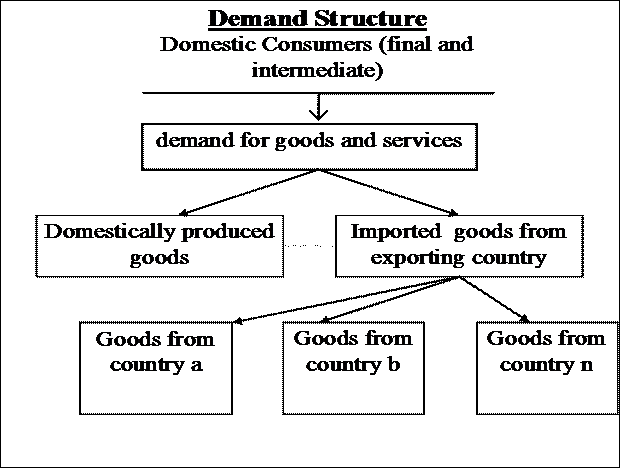Trade - GEM-E3
| Corresponding documentation | |
|---|---|
| Previous versions | |
| Model information | |
| Model link | |
| Institution | Institute of Communication And Computer Systems (ICCS), Greece, https://www.iccs.gr/en/. |
| Solution concept | General equilibrium (closed economy) |
| Solution method | Optimization |
| Anticipation | |
Total domestic demand consists of the demand of products by the consumers, the producers (for intermediate consumption and investment) and the public sector. This is allocated between domestic products and imported products, according to the Armington specification. Each country buys and imports at the prices set by the supplying countries following their export supply behaviour.
Figure 11: Trade matrix for EU and the rest of the world
GEM-E3 employs a nested commodity aggregation hierarchy, in which branch’s i total demand is modelled as demand for a composite good or quantity index Yi which is defined over demand for the domestically produced variant and the aggregate import good. At a next level, demand for imports is allocated across imported goods by country of origin. Bilateral trade flows are thus treated endogenously in GEM-E3.
Figure 12: Domestic demand and trade flows nesting scheme
The minimum unit cost of the composite good determines its selling price. This is formulated through a CET unit cost function, involving the selling price of the domestic good, which is determined by goods market equilibrium, and the price of imported goods, which is taken from the 2nd level Armington. By applying Shephard’s lemma, total demand for domestically produced goods and for imported goods is derived.
Export of services from country cr to country cs will be equal to the bilateral import of services of country cs from cr. The model ensures analytically that, the balance of trade matrix in value and the global Walras law is verified in all cases. A trade flow from one country to another country matches, by construction, the inverse flow. The model ensures this symmetry in volume, value and deflator. Thus the model guarantees (in any scenario run) all balance conditions applied to the world trade matrix, as well as the Walras law at the level of the planet.

